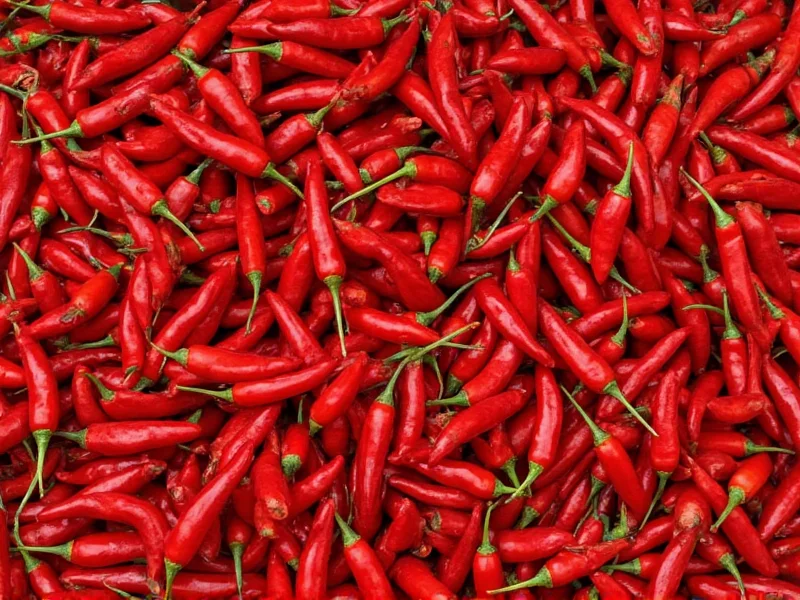When you search what is red chilli, you're likely seeking clear botanical and culinary clarification about this common kitchen staple. Unlike green chillies harvested early, red chillies represent the mature stage of various capsicum varieties, offering distinct flavor profiles and nutritional benefits that make them indispensable in kitchens worldwide.
Botanical Identity and Development
Scientifically classified as Capsicum annuum (though some varieties belong to C. frutescens or C. chinense), red chillies begin as green peppers that gradually ripen through yellow and orange stages before reaching their characteristic red hue. This color transformation occurs as chlorophyll breaks down and carotenoids like capsanthin develop. The ripening process typically takes 70-90 days from flowering, depending on climate and variety.
Understanding what is red chilli requires recognizing that color alone doesn't define these peppers. Their heat level, measured in Scoville Heat Units (SHU), ranges dramatically from mild (1,000 SHU) to extremely hot (500,000+ SHU), influenced by genetics and growing conditions rather than color alone.
Common Varieties and Their Characteristics
Exploring what is red chilli reveals numerous varieties with distinct properties. The following table compares popular types:
| Variety | Heat Level (SHU) | Flavor Profile | Common Uses |
|---|---|---|---|
| Cayenne | 30,000-50,000 | Sharp, pungent | Hot sauces, spice blends |
| Ancho | 1,000-2,000 | Smoky, raisin-like | Moles, stews |
| Thai Bird's Eye | 50,000-100,000 | Intense, citrusy | Asian curries, dipping sauces |
| Guajillo | 2,500-5,000 | Berry-like, tangy | Salsas, marinades |
Nutritional Composition and Health Impacts
When examining what is red chilli from a nutritional perspective, these peppers prove remarkably beneficial. A single tablespoon (6g) of dried red chilli contains:
- Approximately 17 calories
- 132% of daily vitamin A needs
- 43% of recommended vitamin C
- Significant vitamin E, B6, and potassium
- High capsaicin concentration (0.1-1.5%)
The compound responsible for heat, capsaicin, interacts with pain receptors to create the burning sensation while triggering endorphin release. Research on health benefits of red chilli suggests potential metabolic boosts, pain relief properties, and cardiovascular support, though individual tolerance varies considerably.
Culinary Transformation: From Fresh to Dried
Understanding what is red chilli requires distinguishing between fresh and dried forms. Fresh red chillies offer bright, grassy notes with varying heat levels, while drying concentrates flavors and often intensifies heat. The drying process converts some capsaicinoids into different compounds, creating more complex flavor profiles.
Chefs seeking to understand difference between red and green chilli should note that ripeness affects more than color. Red chillies generally contain 2-3 times more vitamin C and significantly higher carotenoid content than their green counterparts. The extended time on the plant allows sugars to develop, creating sweeter, fruitier notes alongside the heat.
Global Culinary Significance
No exploration of what is red chilli would be complete without acknowledging its worldwide culinary impact. In Indian cuisine, dried red chillies form the backbone of masalas and curries. Hungarian paprika, made from specific sweet and hot red pepper varieties, defines goulash and other national dishes. In Chinese cooking, dried red chillies provide both heat and distinctive aroma to Sichuan dishes.
The versatility of red chillies explains why understanding how to use red chilli in cooking matters to home cooks globally. Whole dried peppers can be toasted to enhance flavor before grinding, while fresh varieties work well in salsas and stir-fries. The seeds and inner membranes contain the highest capsaicin concentration, allowing cooks to adjust heat levels precisely.
Practical Handling and Storage Guidelines
When working with red chillies, proper handling ensures both safety and flavor preservation. Always wash hands thoroughly after handling hot varieties, and avoid touching your face. For long-term storage, dried red chillies maintain quality for 6-12 months in airtight containers away from light, while fresh peppers last 2-3 weeks refrigerated.
Those exploring what is red chilli powder should know that commercial powders often contain additional ingredients. Pure chilli powder consists solely of ground dried peppers, while many store-bought versions include salt, garlic powder, or other spices. Making your own powder guarantees authenticity and allows customization of heat levels.
Common Misconceptions Clarified
Several myths surround red chillies that deserve clarification. Contrary to popular belief, the heat doesn't primarily come from seeds but from the white pith surrounding them. Additionally, while many assume all red chillies are extremely hot, varieties like bell peppers (technically chillies without capsaicin) demonstrate the spectrum of possibilities within the red pepper family.
Understanding red chilli vs cayenne pepper reveals that cayenne is actually a specific type of red chilli, not a separate category. The term 'cayenne' typically refers to long, thin, moderately hot red chillies, while 'red chilli' encompasses numerous varieties with varying shapes, sizes, and heat levels.











 浙公网安备
33010002000092号
浙公网安备
33010002000092号 浙B2-20120091-4
浙B2-20120091-4